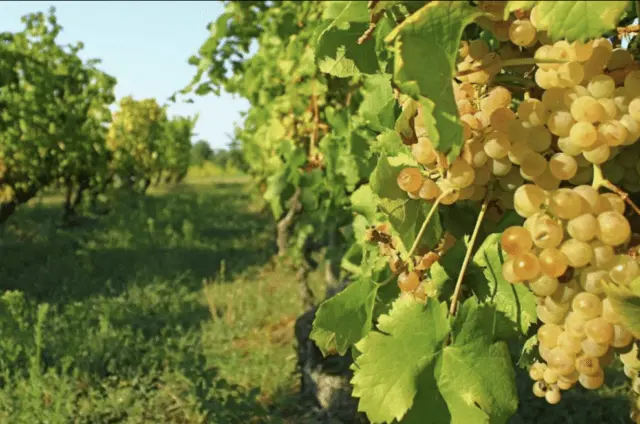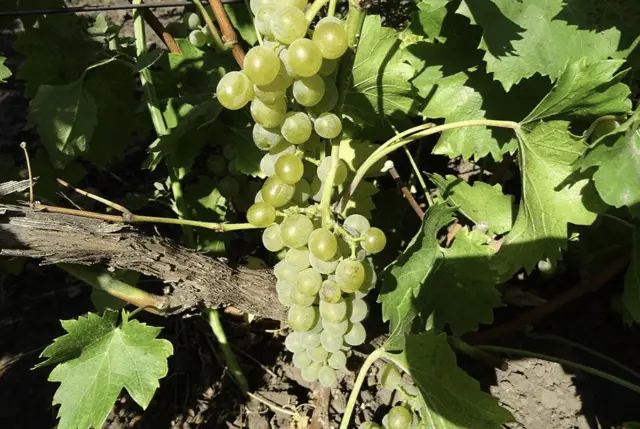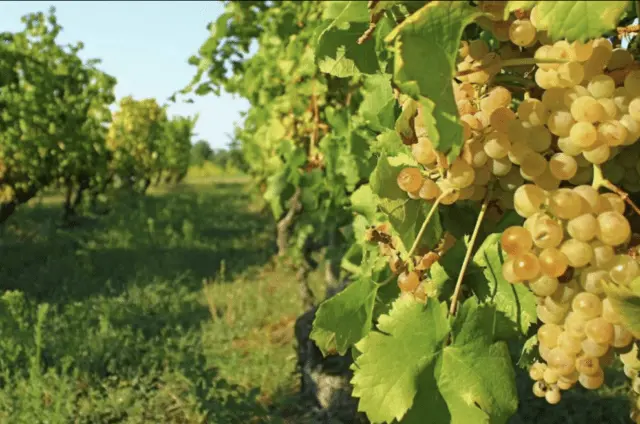Contents
Bianca grapes are a winter-hardy variety that can withstand frosts down to -25 degrees. Approved for cultivation in the southern regions and regions of the Black Earth region. The variety is productive and unpretentious. Berries are used to make wine, juices and nectars.
The story of
Grape Bianca (Vitis L.) is a variety bred on the basis of the Federal State Budgetary Scientific Institution “Federal Rostov Agricultural Research Center” (Rostov Region). The same organization is currently the originator. The application was filed in 1990. The variety was registered in the register of breeding achievements of Our Country in 1993.
Description of the grape variety Bianca
Bianca is an early variety of fruity white grapes. It is a vigorous shrub with medium-sized leaves of a typical green color. The upper side of the leaf plate is smooth, light green veins are visible against the general background. Their profile is wavy or funnel-shaped, the blades rise along the edges. There is no omission. The edges of the sheet are serrated, the teeth are large, triangular, clearly visible.
The upper cuts are moderately deep, they are closed or open in the form of incoming corners. The lower notches are small, barely noticeable or completely absent. Petiole notches are open, vaulted, have a flat or rounded bottom. Petioles are long, green, often with reddish tints. The flowers of the grape variety Bianca are bisexual, the plant is monoecious. Therefore, pollination is quite high, the fruits are tied well.
bunches
Clusters of small size. By weight, on average 140-150 g, less often up to 300-350 g. Clusters contain approximately 80-100 berries. Cylindrical shape, average density. The leg is short. Clusters can hang on the vine for a long time. The fruits do not crumble, which makes it possible to plan convenient harvesting dates.
Berries
Bianca grapes are small in size, weighing an average of 1,4 g, sometimes up to 2 g. The shape is oval. Their skin is thin. Each berry has two seeds, sometimes less or more. The taste is simple, fruity aroma is felt. The pulp is slightly fleshy, has a high juiciness. The fruits are not prone to peas. The color is greenish-yellow, the skin itself has a slight white coating.

Berries ripen in 4-4,5 months
Vine
The vine ripens well, which ensures a consistently high yield. As they mature, the shoots acquire a rich brown color.
The ovaries and inflorescences practically do not crumble, but due to return frosts and temperature changes, a small part of the flowers may not open.
Characteristics of the Bianca grape
The Bianca variety is unpretentious, the bushes withstand frost, drought, temperature extremes and cool summers well. Even with standard agricultural practices, stable yields can be achieved.
Ripening time for Bianca grapes
From the moment of bud break in the spring to the stage of technical ripeness of berries, 120 days pass. Therefore, the Bianca grape belongs to the early ripening varieties. For berries with a richer and less acidic taste, it is recommended to wait a few more weeks and plan to harvest at a later date.
Productivity
Adult bushes of Bianca grapes produce an average of 5 kg of berries, and in a good season and subject to agricultural technology – up to 10 kg. In industrial cultivation, the indicator is 120-130 kg / ha.
Sugar content of Bianca grapes
The sugar content of Bianca grapes ranges from 26 to 28 g per 100 ml of pure juice. Total acidity – 9% at the initial stage of harvesting, then decreases to 7% at the stage of full maturity.
Growing regions
The Bianca grape variety is approved for cultivation in the Black Earth Region and the North Caucasus region. The culture can be cultivated in all southern regions, as well as in the Voronezh, Oryol, Tambov, Belgorod, Kursk regions.
Frost resistance
The Bianca variety is characterized by increased winter hardiness. Grapes withstand even extreme frosts down to -25 degrees. Therefore, when grown in the Chernozem region and the southern regions, the bushes do not cover for the winter. However, young, recently planted seedlings should be insulated.
Drought tolerance
Bianca is drought tolerant. However, during a long dry period, the bushes need additional watering.

To get a good harvest, the bushes need to be moistened regularly.
Disease and pest resistance
The variety is resistant to most diseases. Bianca grapes are not affected by gray mold and many other fungal infections. For prevention, it is enough to carry out a single treatment at the beginning of the season. Resistant to root phylloxera is noted. However, plants can suffer from wasps and other insects. Therefore, additional protective measures must be taken:
- traps;
- containers with fermenting compote;
- insecticide (for example, “Aktara”, “Decis”, “Inta-Vir”, “Match” and others).
Methods of Use
Bianca grapes belong to wine varieties, the main purpose of the berries is technical. Most often, the fruits are not consumed fresh, but sent for processing. The yield of juice reaches 80% of the mass of the crop. Dry white wines, fortified drinks are produced from the Bianca variety, less often they are used for the production of cognac distillates.
The juice is aged in oak barrels for several years, as a result of which it acquires a honey aroma with floral hints. The wine is harvested both on the basis of the Bianca variety and in blends with other varieties of grapes. Another area of application is the production of juices and nectars.
Advantages and disadvantages
Bianca grapes are valued for their high winter hardiness and unpretentiousness. The culture is productive, and the taste of the berries is good enough, which allows them to be used for the preparation of alcoholic and non-alcoholic drinks.

The Bianca variety is characterized by a stable yield
Pros:
- very high winter hardiness;
- can be grown in different regions of Our Country;
- the ovaries do not crumble;
- good fruit set;
- immunity to diseases and pests.
Cons:
- can suffer from wasps and birds;
- transportability is average;
- clusters are small, so harvesting is difficult;
- demanding for abundant sunlight.
Plant the Bianca grape
Bianca grape seedlings can be purchased at a nursery or you can take a few cuttings from your neighbors, sprouting them in open ground. A place for landing is chosen illuminated, without a shadow, but protected from strong winds and without stagnant moisture (better elevation, lowlands are excluded). The soil should be loose and fertile, with a neutral reaction of the environment (pH from 6,0 to 7,0).
Landing can be scheduled for both spring and autumn. The timing depends on the climatic features of the region:
- in the Chernozem region, seedlings are planted from April to mid-May;
- in the south, landing can be started in late March – early April;
- reserve period: the last ten days of September – the first half of October (at least one month before the expected frosts).
The algorithm for planting Bianca grapes is standard:
- In a few weeks, dig holes 50 * 50 cm at a distance of at least 2,5 m from each other.
- Lay a layer of drainage (small stones), and on top – garden soil with humus, peat and sand (2: 1: 1: 1).
- A few hours before planting, soak the roots of the seedlings in a growth stimulant solution (Epin, Kornevin, Zircon or another remedy).
- Plant seedlings in the center, sprinkle with soil and tamp so that the root collar goes to a depth of 10 cm.
- Lay out sawdust, straw, hay or other mulch. In the case of autumn planting, the layer should be 10-15 cm.
Bianca grape care
Variety Bianca is unpretentious. To get a good harvest, you need to provide watering and other care measures:
- Irrigate plantings regularly, preventing the surface layer of the soil from drying out completely. In a drought, watering is carried out at least once a week, the norm is two buckets per bush.
- Top dressing is applied in the spring and during fruiting. First, they give superphosphate (200 g per bush) and ammonium sulfate (100 g per plant), and in summer – a complex mineral fertilizer (70 g per well).
- The soil is regularly loosened, weeded.
- Next to the bushes, supports (pegs) are driven in, to which branches are necessarily tied.
- Pruning is done in the second half of spring and in the middle of autumn. On each shoot, it is recommended to leave three eyes to ensure optimal load on the bush.

Agrotechnics for growing the Bianca variety is standard
Conclusion
Bianca grapes are a variety that has several objective advantages at once. It withstands frost, drought, has immunity to a number of diseases. Therefore, the culture can be recommended for growing both experienced gardeners and beginners.









